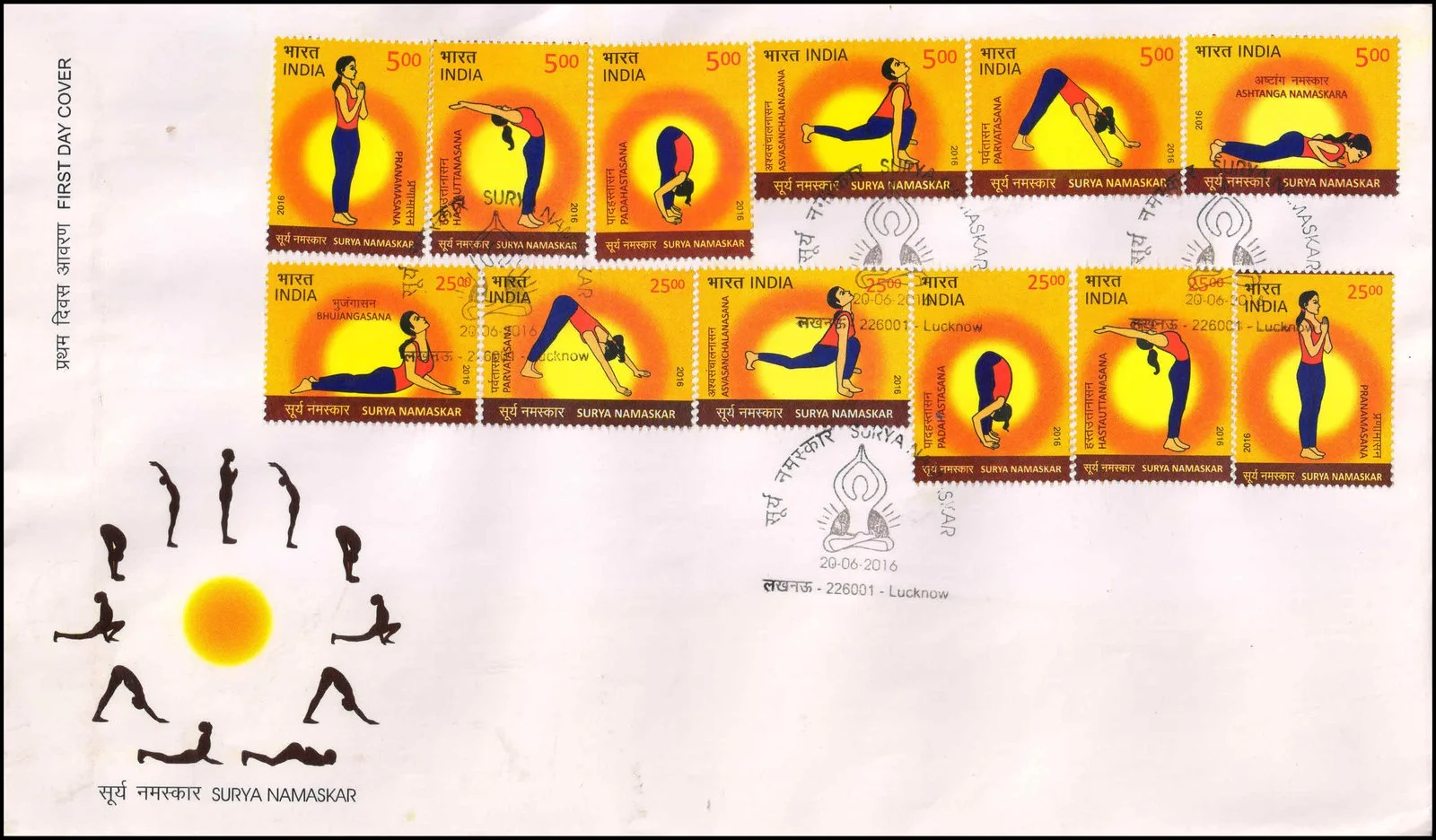Hastauttanasana

Technical Data
| Stamp Set | Surya Namaskar |
|---|---|
| Date of Issue | June 20, 2016 |
| Denomination | Rs. 5 |
| Quantity | 300,000 |
| Perforation | 13¾ x 13¼ |
| Printer | Security Printing Press, Hyderabad |
| Printing Process | Wet Offset |
| Watermark | No Watermark |
| Colors | Multicolor |
| Credit (Designed By) | Ms. Nenu Gupta |
| Catalog Codes |
Michel IN 2967A Yvert et Tellier IN 2681 Stanley Gibbons IN 3138 |
| Themes | Women |
Introduction
Hastauttanasana, known as the Raised Arms Pose, is the second and eleventh posture of the Surya Namaskar sequence. The Sanskrit term is derived from ‘Hasta’ meaning hands and ‘Uttana’ meaning to stretch or extend. This asana opens the body to receive energy, encouraging expansion, vitality, and an uplifting state of mind. It acts as a graceful transition from the centering stillness of Pranamasana to a dynamic flow of movement and breath.
Origin and Significance
Rooted in the ancient Yogic principle of energizing the body through breath and movement, Hastauttanasana symbolizes openness to the universe. The upward stretch aligns the spine, activates the prana (life force), and expands the chest to enhance lung capacity. Practicing this asana expresses a gesture of welcoming light, positivity, and awareness, making it a vital part of the Surya Namaskar routine.
How to Practice Hastauttanasana
- From Pranamasana, inhale deeply and raise both arms above the head.
- Keep the arms shoulder-width apart and elbows straight.
- Gently arch the upper body backward, stretching from the fingertips to the toes.
- Lift the chest and tilt the head back slightly, without straining the neck.
- Maintain balance while keeping the awareness on the stretch of the abdomen and expansion of the lungs.
This posture should be practiced with slow, controlled breathing for a smooth and comfortable stretch.
Benefits of Hastauttanasana
Hastauttanasana offers a wide range of physical, mental, and respiratory benefits, making it an energizing posture for daily practice.
Physical Benefits
- Stretches the entire body, especially the abdomen, chest, arms, and spine
- Strengthens shoulder and upper back muscles
- Improves posture and enhances spinal flexibility
- Helps stimulate digestion by expanding the abdominal region
Mental and Emotional Benefits
- Promotes alertness and reduces lethargy
- Encourages confidence, positivity, and mental clarity
- Helps release emotional blockages stored in the chest area
Respiratory Benefits
- Expands the lungs and improves breathing capacity
- Enhances oxygen intake, refreshing the body and mind
Role in Surya Namaskar
As the second and eleventh posture of Surya Namaskar, Hastauttanasana shifts the practitioner from a grounded state of Pranamasana to a state of upward expansion. It prepares the body for deeper forward bending and subsequent poses. By opening the chest and lengthening the spine, it promotes the smooth flow of prana and supports rhythmic coordination of breath with movement.
Conclusion
Hastauttanasana is a powerful yet graceful posture that awakens the body with energy and lightness. Beyond its physical stretch, the pose cultivates openness, positivity, and a deep sense of inner upliftment. Regular practice enhances flexibility, breathing, and vitality, setting the tone for a balanced and invigorating yoga session. As an integral part of Surya Namaskar, Hastauttanasana encourages an expansive connection between body, mind, and breath.
Commemorative Stamps on Surya Namaskar
To mark International Yoga Day on 21 June 2016, the Department of Posts released a set of 12 Commemorative Postage Stamps, each depicting one of the 12 positions of Surya Namaskar—highlighting Yoga’s cultural and spiritual significance.
First Day Cover

